271. Red Knot Calidris canutus (Knoet)
Order: Charadriiformes. Family: Scolopacidae
Description
Length 23-26 cm. Wingspan 47-53 cm. A short-billed wader with lack bill and olive-green legs.
Summer (breeding plumage): Brick red/chestnut, apart from white under-tail coverts and grey wings with a light bar and dark tips
Winter (non-breeding plumage: Reddish parts become grey-brown above and white below.
Juvenile birds have distinctive submarginal lines and brown coverts during the first year.
Distribution: Breeds in the high Arctic, in the tundra mainly above 70° North, heading south in the non-breeding season to Europe, South-East Asia, Australasia, Central and South America and Africa's west coast from Mauritania through West Africa to southern Africa. C. c. canutus breeds in West-Siberia and flies via Europe to West- and South-Africa. Here it is locally fairly common along the west coast from Namibia to the Cape Peninsula, Western Cape, while more scarce further east in the Eastern Cape and KwaZulu-Natal.
Three large tidal inlets, Walvis Bay Lagoon, Sandwich Harbour and Langebaan Lagoon, support about two-thirds of the southern African population.
Habitat
It generally prefers large mud and sand flats in sheltered coastal lagoon and embayments, occurring less regularly in coastal wetlands, estuaries, and open coasts.
Movements and migrations
The provenance of those that spend the non-breeding season in southern Africa is likely to be the Taimyr Peninsula in Siberia. Departs from its breeding grounds in July to head down the east Atlantic seaboard and eventually reaching southern Africa from September-October, leaving again in mid April. It is capable of flying non stop for over 4000 km's, although some birds may be incapable of making the journey back to the breeding grounds and so stay in southern Africa through winter. The proportion of juveniles in the region is linked to the abundance of lemmings at its breeding colonies, as they are the main prey of Arctic foxes. About every third year lemmings are much more scarce, so the foxes resort to feeding on the chicks of ground-nesting birds, including the Red knot. This means that that juveniles represent 24-61% of all the Red knots at Langebaan Lagoon in normal years, but when lemmings are scarce the proportion of juveniles is just 0 - 7%.
Diet
Molluscs, crustaceans and other intertidal invertebrates. It mainly eats bivalves, especially Tellimaya trigona, supplemented with other molluscs (including the snail Hydrobia), polychaetes, crustaceans and echnoderms, doing most of its foraging by pecking the ground or probing the mud while moving forwards. It often joins mixed species flocks along with other waders, such as Curlew sandpipers and Little stints.
Breeding
The Red Knot is territorial and seasonally monogamous. The Red Knot nests on the ground, near water, and usually inland. The nest is a shallow scrape lined with leaves, lichens and moss. Males construct three to five nest scrapes in their territories prior to the arrival of the females. The female lays three or more usually four eggs. They are incubated by both adults. The incubation period lasting around 22 days. The chicks are precocial at hatching. The male tends the young until they fledge.
Call
Contact call low-pitched knut. Listen to Bird Call.
Status
Common summer visitor.
Africa Wild Bird Book
Red Knot Photos
271. Red Knot Calidris canutus (Knoet)
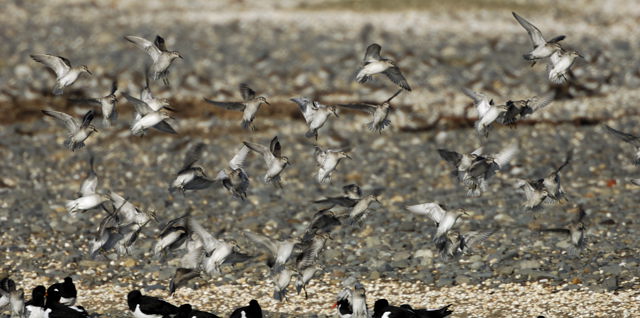
Non-breeding plumage
Links:
Species text in The Atlas of Southern African Birds
Sabap2: http://sabap2.adu.org.za/spp_summary.ph ... §ion=3
ARKive: http://www.arkive.org/red-knot/calidris-canutus/
Hockey, P.A.R. 1998. Africa’s waders: a guide to their identification. Part 1. Africa - Birds & Birding 3(1):53-61.

Non-breeding plumage
Links:
Species text in The Atlas of Southern African Birds
Sabap2: http://sabap2.adu.org.za/spp_summary.ph ... §ion=3
ARKive: http://www.arkive.org/red-knot/calidris-canutus/
Hockey, P.A.R. 1998. Africa’s waders: a guide to their identification. Part 1. Africa - Birds & Birding 3(1):53-61.
Dewi
What is the good of having a nice house without a decent planet to put it on? (H D Thoreau)
What is the good of having a nice house without a decent planet to put it on? (H D Thoreau)
Sanderling
281. Sanderling Calidris alba (Drietoonstrandloper)
Order: Charadriformes. Family: Scolopacidae
Description
Length 20-21 cm, mass 41-102 g. A small shorebird of very white appearance with dark shoulder-patch and short, thick bill; larger and paler than any stint.
One of the most widespread of all shorebirds, the sanderling is a small, highly active wader, typically seen racing after waves on sandy beaches as it hunts for small food items along the waterline. It is quite a plump species, with a short, stout, black beak and black legs, and is unique amongst sandpipers in that it lacks a hind toe, as an adaptation for running fast on sand. At all times of year the sanderling can be recognised by its pure white underparts and broad white wingbar, bordered with black, which is visible in flight.
Ad breeding: Head, neck and upper mantle chestnut (extent and intensity variable; female often paler)3, streaked blackish brown; central forehead and crown darkest. Indistinct, narrow black loral stripe extends as eye stripe to ear coverts. Lower mantle feathers, scapulars and tertials blackish, rufous-edged and white-tipped; some non-br tertials retained. Back, rump and central upper tail coverts black, narrowly fringed rufous; some non-br (dull grey) feathers retained. Central rectrices blackish, narrowly fringed white. Outer rectrices progressively paler grey, with increasing amount of white at bases of inner webs. Lesser upper wing coverts and primary coverts black, inner primary coverts tipped white. Median and greater upper wing coverts grey, former narrowly edged whitish, latter broadly tipped white. Outer primaries dark grey (blackish on outer webs, inner webs basally white). Inner primaries with basal 50% white; shafts white. Secondaries white basally, dark grey distally. White of flight feathers and coverts forms broad, conspicuous wing bar. Chin white, variably tinged rufous. Throat, foreneck and upper breast rufous (often paler in female), finely speckled black. Rufous extends down sides of lower breast, where black markings become 'U'-shaped, or chevrons. Remainder of underparts white. Underwing coverts and axillaries white (grey bases to lesser coverts form narrow, dark leading edge); flight feathers pale grey to white from below, trailing edge darker. Bill black, shorter than head length, slightly drooped, with bulbous tip; narrow white ring of feathers around base. Eyes dark brown. Legs and feet black.
Ad non-breeding: Overall very pale grey above, white below. Forehead and supercilium white, lores spotted grey; dark smudge in front of and below eye. Crown, ear coverts and sides and back of neck pale grey; feather shafts dark. Mantle to upper tail coverts pale grey, feathers narrowly edged white, with dark shafts. Lateral tail coverts and edges of rump white, longest tail coverts black. Primary and lesser upper wing coverts black, latter tipped white. Dark lesser coverts form distinctive black carpal patch on folded wing. Remainder of upper wing and tail as br ad. Underparts white, except for small grey patches on sides of upper breast.
Juveniles resemble the non-breeding adult, but are more darkly marked with black and white on the back, and have a buffy breast and head, streaked with black.
Distribution
Breeds in northern Canadian Arctic, Greenland, Siberia, after which it disperses across the world's coasts and islands. It is common along the entire southern African coastline, especially along the west coast, while recorded fairly regularly in wetlands further inland.
Habitat
It generally prefers sandy beaches, but it also occurs at rocky shores, lagoons and bare edges of wetlands.
Breeding
Nesting habitat is rocky tundra. 3-4 eggs are laid in a ground scrape. Some females lay one clutch which is then attended by both parents; others lay one clutch which they leave for the male to attend and shortly after a second clutch which is only attended by the female.
Movements and migrations
Intercontinental migrant, with most southern African birds arriving in small flocks from early September, all originating from breeding grounds in Siberia and Greenland. They eventually depart from the region in mid May.
Diet
It mainly eats invertebrates, supplemented with small fish, doing most of its foraging in flocks during the falling tide, pecking the soil or plucking food items from rocks. It may also probe with the beak in wet sand and mud, with sensors in the beak enabling it to detect prey up to two centimetres away It mainly forages on moist sand to avoid confrontation with white-fronted plovers, who often chase other birds out of their territories.
Call
The calls of this species include a short, soft twick or wick wick, and the male gives a frog-like call in flight over the breeding grounds. Listen to bird call
Status
Common summer visitor. Not threatened.
Order: Charadriformes. Family: Scolopacidae
Description
Length 20-21 cm, mass 41-102 g. A small shorebird of very white appearance with dark shoulder-patch and short, thick bill; larger and paler than any stint.
One of the most widespread of all shorebirds, the sanderling is a small, highly active wader, typically seen racing after waves on sandy beaches as it hunts for small food items along the waterline. It is quite a plump species, with a short, stout, black beak and black legs, and is unique amongst sandpipers in that it lacks a hind toe, as an adaptation for running fast on sand. At all times of year the sanderling can be recognised by its pure white underparts and broad white wingbar, bordered with black, which is visible in flight.
Ad breeding: Head, neck and upper mantle chestnut (extent and intensity variable; female often paler)3, streaked blackish brown; central forehead and crown darkest. Indistinct, narrow black loral stripe extends as eye stripe to ear coverts. Lower mantle feathers, scapulars and tertials blackish, rufous-edged and white-tipped; some non-br tertials retained. Back, rump and central upper tail coverts black, narrowly fringed rufous; some non-br (dull grey) feathers retained. Central rectrices blackish, narrowly fringed white. Outer rectrices progressively paler grey, with increasing amount of white at bases of inner webs. Lesser upper wing coverts and primary coverts black, inner primary coverts tipped white. Median and greater upper wing coverts grey, former narrowly edged whitish, latter broadly tipped white. Outer primaries dark grey (blackish on outer webs, inner webs basally white). Inner primaries with basal 50% white; shafts white. Secondaries white basally, dark grey distally. White of flight feathers and coverts forms broad, conspicuous wing bar. Chin white, variably tinged rufous. Throat, foreneck and upper breast rufous (often paler in female), finely speckled black. Rufous extends down sides of lower breast, where black markings become 'U'-shaped, or chevrons. Remainder of underparts white. Underwing coverts and axillaries white (grey bases to lesser coverts form narrow, dark leading edge); flight feathers pale grey to white from below, trailing edge darker. Bill black, shorter than head length, slightly drooped, with bulbous tip; narrow white ring of feathers around base. Eyes dark brown. Legs and feet black.
Ad non-breeding: Overall very pale grey above, white below. Forehead and supercilium white, lores spotted grey; dark smudge in front of and below eye. Crown, ear coverts and sides and back of neck pale grey; feather shafts dark. Mantle to upper tail coverts pale grey, feathers narrowly edged white, with dark shafts. Lateral tail coverts and edges of rump white, longest tail coverts black. Primary and lesser upper wing coverts black, latter tipped white. Dark lesser coverts form distinctive black carpal patch on folded wing. Remainder of upper wing and tail as br ad. Underparts white, except for small grey patches on sides of upper breast.
Juveniles resemble the non-breeding adult, but are more darkly marked with black and white on the back, and have a buffy breast and head, streaked with black.
Distribution
Breeds in northern Canadian Arctic, Greenland, Siberia, after which it disperses across the world's coasts and islands. It is common along the entire southern African coastline, especially along the west coast, while recorded fairly regularly in wetlands further inland.
Habitat
It generally prefers sandy beaches, but it also occurs at rocky shores, lagoons and bare edges of wetlands.
Breeding
Nesting habitat is rocky tundra. 3-4 eggs are laid in a ground scrape. Some females lay one clutch which is then attended by both parents; others lay one clutch which they leave for the male to attend and shortly after a second clutch which is only attended by the female.
Movements and migrations
Intercontinental migrant, with most southern African birds arriving in small flocks from early September, all originating from breeding grounds in Siberia and Greenland. They eventually depart from the region in mid May.
Diet
It mainly eats invertebrates, supplemented with small fish, doing most of its foraging in flocks during the falling tide, pecking the soil or plucking food items from rocks. It may also probe with the beak in wet sand and mud, with sensors in the beak enabling it to detect prey up to two centimetres away It mainly forages on moist sand to avoid confrontation with white-fronted plovers, who often chase other birds out of their territories.
Call
The calls of this species include a short, soft twick or wick wick, and the male gives a frog-like call in flight over the breeding grounds. Listen to bird call
Status
Common summer visitor. Not threatened.
10.03. - 24.03.2015 From Berg to bush
19.11. - 01.12.2015 KTP
19.11. - 01.12.2015 KTP
Sanderling Photos
281. Sanderling Calidris alba
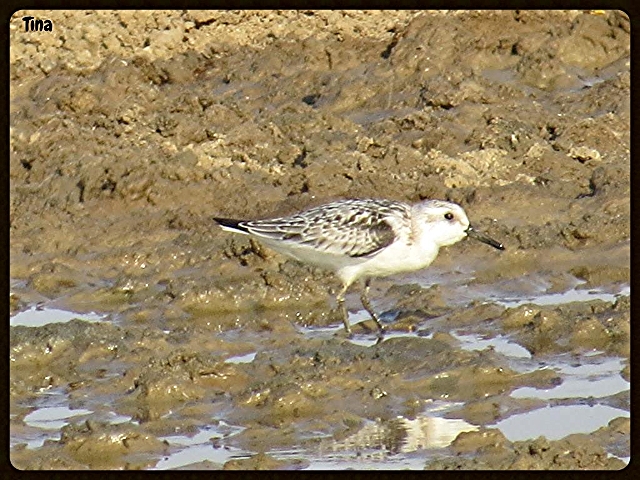 © Tina
© Tina
Kgalagadi Transfrontier Park
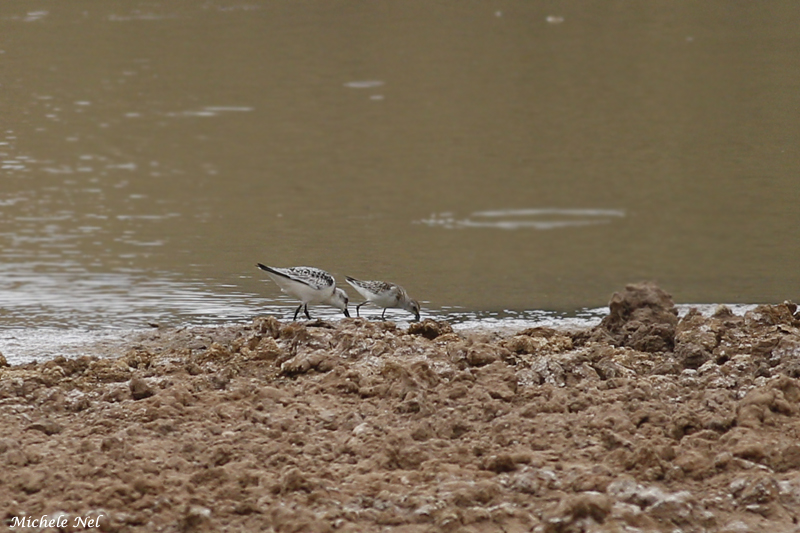
With Little Stint - bird on right - Nossob - Oct 2013, Kgalagadi Transfrontier Park © Michele Nel
Links:
Sabap2
Species Text Sabap1
Arkive
http://www.fitzpatrick.uct.ac.za/sites/ ... 953-61.pdf
 © Tina
© TinaKgalagadi Transfrontier Park

With Little Stint - bird on right - Nossob - Oct 2013, Kgalagadi Transfrontier Park © Michele Nel
Links:
Sabap2
Species Text Sabap1
Arkive
http://www.fitzpatrick.uct.ac.za/sites/ ... 953-61.pdf
10.03. - 24.03.2015 From Berg to bush
19.11. - 01.12.2015 KTP
19.11. - 01.12.2015 KTP
- Sprocky
- Posts: 7110
- Joined: Sat May 19, 2012 12:29 pm
- Country: South Africa
- Location: Grietjie Private Reserve
- Contact:
Little Stint
274. Little Stint Calidris minuta (Kleinstrandloper)
Order: Charadriiformes. Family: Scolopacidae
Description
14 cm. Most common small wader in region. Very small with short dark bill and dark legs, and wings that project beyond tail.
The breeding adult has much rufous on the head and upperparts (may extend on to sides of breast, but throat always white), a creamy-buff 'V' at sides of mantle (visible in flight), and chestnut and buff feather edges with blackish centres giving a strong scaly effect
In non-breeding plumage, it is grey-brown above with dark wedged centres or dark shaft-streaks. The breast has a pale streaked breast band. White below. Bill and legs black.
Juveniles have pale crown stripes and a pinkish breast.
Similar species: Very similar to Red-necked Stint, but with a longer, less stubby bill; in breeding plumage it lacks the rufous chin of that species. Temminck's Stint has olive, not black, legs, plainer upperparts and white, not grey, outer tail feathers. Long-toed Stint has darker upperparts, a thinner bill and greenish yellow legs.
Distribution
It breeds in the Arctic tundra from northern Norway to Siberia, heading south in the non-breeding season to India. Arabia and sub-Saharan Africa. In South Africa, widespread at wetlands coastally and inland, but absent from mountainous, wooded and arid areas.
Habitat
Coastal and inland wetlands, scarce on open coast.
Movements and migrations
Long distance migrant, arriving in southern Africa mainly in August, with numbers peaking from October-December. Returns to the breeding grounds from mid-February to late March (birds in the northern parts leave later). In southern Africa it is highly nomadic, moving in search of recently flooded and overgrown habitats.
Diet
Mostly insects, also crustaceans and molluscs.
Breeding
This bird nests on a scrape in bare ground, laying 3–5 eggs. It is polygamous, and male and female may incubate separate clutches.
Call
Short stit-it notes, creating twittering chorus in flocks. Listen to Bird Call.
Status
Common summer visitor. Non-breeding Palaearctic migrant. Small numbers overwinter. Typically found in small flocks.
Classified as Least Concern (LC) on the IUCN Red List.
Order: Charadriiformes. Family: Scolopacidae
Description
14 cm. Most common small wader in region. Very small with short dark bill and dark legs, and wings that project beyond tail.
The breeding adult has much rufous on the head and upperparts (may extend on to sides of breast, but throat always white), a creamy-buff 'V' at sides of mantle (visible in flight), and chestnut and buff feather edges with blackish centres giving a strong scaly effect
In non-breeding plumage, it is grey-brown above with dark wedged centres or dark shaft-streaks. The breast has a pale streaked breast band. White below. Bill and legs black.
Juveniles have pale crown stripes and a pinkish breast.
Similar species: Very similar to Red-necked Stint, but with a longer, less stubby bill; in breeding plumage it lacks the rufous chin of that species. Temminck's Stint has olive, not black, legs, plainer upperparts and white, not grey, outer tail feathers. Long-toed Stint has darker upperparts, a thinner bill and greenish yellow legs.
Distribution
It breeds in the Arctic tundra from northern Norway to Siberia, heading south in the non-breeding season to India. Arabia and sub-Saharan Africa. In South Africa, widespread at wetlands coastally and inland, but absent from mountainous, wooded and arid areas.
Habitat
Coastal and inland wetlands, scarce on open coast.
Movements and migrations
Long distance migrant, arriving in southern Africa mainly in August, with numbers peaking from October-December. Returns to the breeding grounds from mid-February to late March (birds in the northern parts leave later). In southern Africa it is highly nomadic, moving in search of recently flooded and overgrown habitats.
Diet
Mostly insects, also crustaceans and molluscs.
Breeding
This bird nests on a scrape in bare ground, laying 3–5 eggs. It is polygamous, and male and female may incubate separate clutches.
Call
Short stit-it notes, creating twittering chorus in flocks. Listen to Bird Call.
Status
Common summer visitor. Non-breeding Palaearctic migrant. Small numbers overwinter. Typically found in small flocks.
Classified as Least Concern (LC) on the IUCN Red List.
Sometimes it’s not until you don’t see what you want to see, that you truly open your eyes.
- Sprocky
- Posts: 7110
- Joined: Sat May 19, 2012 12:29 pm
- Country: South Africa
- Location: Grietjie Private Reserve
- Contact:
Little Stint Photos
274. Little Stint Calidris minuta
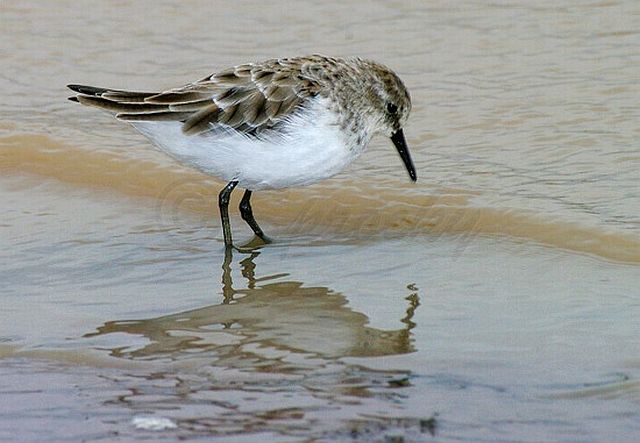 © Sprocky
© Sprocky

Macaneta Wetlands, about 30 kms north of Maputo © Dindingwe
 © nan
© nan
Strandfontein
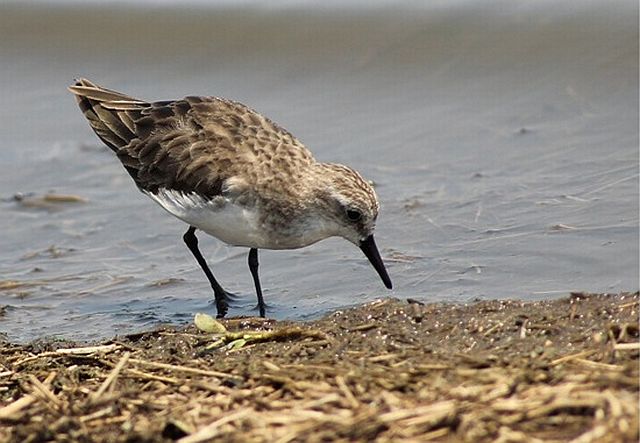 © Amoli
© Amoli
Kruger National Park, Sunset Dam
Links:
Species text in The Atlas of Southern African Birds
Sabap2
Hockey, P.A.R. 1998. Africa’s waders: a guide to their identification. Part 1. Africa - Birds & Birding 3(1):53-61.
 © Sprocky
© SprockyMacaneta Wetlands, about 30 kms north of Maputo © Dindingwe
 © nan
© nanStrandfontein
 © Amoli
© AmoliKruger National Park, Sunset Dam
Links:
Species text in The Atlas of Southern African Birds
Sabap2
Hockey, P.A.R. 1998. Africa’s waders: a guide to their identification. Part 1. Africa - Birds & Birding 3(1):53-61.
Sometimes it’s not until you don’t see what you want to see, that you truly open your eyes.
White-rumped Sandpiper
277. White-rumped Sandpiper Calidris fuscicollis (Witrugstrandloper)
Order: Charadriiformes. Family: Scolopacidae
Description
15-17 cm. Small, plain sandpiper with a white rump, conspicuous in flight. Short bill, slightly down-curved at tip. Long wings usually extend beyond tail.
Breeding: Dark brown scaly upperparts, mainly white underneath, brown streaks on the breast, white rump, streaked flanks, white stripe over eyes, black legs and a small thin dark bill.
In non-breeding plumage, this species is pale grey above with dark centres to grey-fringed scapulars. White eyebrow. White band across upper tail. Dark legs. Some yellow at the base of the bill.
Juvenile: Black-based back feathers and wing coverts with brown edges to scapulars and whiter edges to wing coverts. White "V" on back. Finely streaked breast. White underparts. White supercilium with brownish crown and pale face
Similar species: The White-rumped Sandpiper is one of a group of very similar small shorebirds called "peeps". In flight, it can be differentiated from the other species by its white rump. At rest, it is larger and noticeably longer-winged than all but the Baird's Sandpiper. Similar in shape and size to Baird's Sandpiper, but has longer, very slightly decurved bill and a white rump.
Resembles Curlew Sandpiper, but is smaller and has a shorter, straighter bill. Its wings extend beyond the tail.
Distribution
Nearctic breeder wintering in South America. Breeds in Arctic Canada from Baffin Island to Mackenzie Island, heading south in the non-breeding season to South America, but it is also a rare vagrant to Europe. Australasia and Africa, including southern Africa. Here it is has occasionally been sighted on the coast and further inland in central and northern Namibia, the coast of the Western and Eastern Cape and the North-West Province.
Habitat
Wetlands with muddy fringes. It generally prefers coastal and inland wetlands, especially estuarine mudflats, sewage works and coastal lagoons.
Diet
Invertebrates. It mainly forages by wading through water and probing the mud, often in flocks with Little stints and Curlew sandpipers.
Call
Flight call mouse-lie high-pitched jeet or yee-yeet, unlike any other wader. Listen to Bird Call.
Status
Vagrant.
Order: Charadriiformes. Family: Scolopacidae
Description
15-17 cm. Small, plain sandpiper with a white rump, conspicuous in flight. Short bill, slightly down-curved at tip. Long wings usually extend beyond tail.
Breeding: Dark brown scaly upperparts, mainly white underneath, brown streaks on the breast, white rump, streaked flanks, white stripe over eyes, black legs and a small thin dark bill.
In non-breeding plumage, this species is pale grey above with dark centres to grey-fringed scapulars. White eyebrow. White band across upper tail. Dark legs. Some yellow at the base of the bill.
Juvenile: Black-based back feathers and wing coverts with brown edges to scapulars and whiter edges to wing coverts. White "V" on back. Finely streaked breast. White underparts. White supercilium with brownish crown and pale face
Similar species: The White-rumped Sandpiper is one of a group of very similar small shorebirds called "peeps". In flight, it can be differentiated from the other species by its white rump. At rest, it is larger and noticeably longer-winged than all but the Baird's Sandpiper. Similar in shape and size to Baird's Sandpiper, but has longer, very slightly decurved bill and a white rump.
Resembles Curlew Sandpiper, but is smaller and has a shorter, straighter bill. Its wings extend beyond the tail.
Distribution
Nearctic breeder wintering in South America. Breeds in Arctic Canada from Baffin Island to Mackenzie Island, heading south in the non-breeding season to South America, but it is also a rare vagrant to Europe. Australasia and Africa, including southern Africa. Here it is has occasionally been sighted on the coast and further inland in central and northern Namibia, the coast of the Western and Eastern Cape and the North-West Province.
Habitat
Wetlands with muddy fringes. It generally prefers coastal and inland wetlands, especially estuarine mudflats, sewage works and coastal lagoons.
Diet
Invertebrates. It mainly forages by wading through water and probing the mud, often in flocks with Little stints and Curlew sandpipers.
Call
Flight call mouse-lie high-pitched jeet or yee-yeet, unlike any other wader. Listen to Bird Call.
Status
Vagrant.
Dewi
What is the good of having a nice house without a decent planet to put it on? (H D Thoreau)
What is the good of having a nice house without a decent planet to put it on? (H D Thoreau)
White-rumped Sandpiper Photos
277. White-rumped Sandpiper Calidris fuscicollis (Witrugstrandloper)
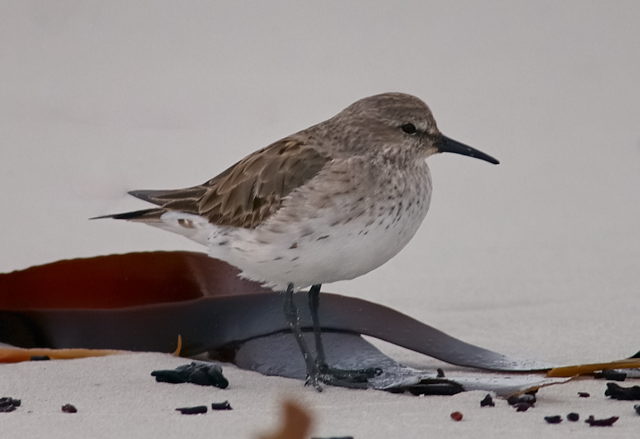
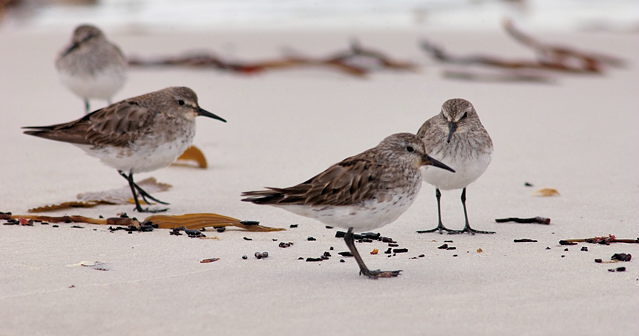
Links:
Hockey, P.A.R. 1998. Africa’s waders: a guide to their identification. Part 1. Africa - Birds & Birding 3(1):53-61.


Links:
Hockey, P.A.R. 1998. Africa’s waders: a guide to their identification. Part 1. Africa - Birds & Birding 3(1):53-61.
Dewi
What is the good of having a nice house without a decent planet to put it on? (H D Thoreau)
What is the good of having a nice house without a decent planet to put it on? (H D Thoreau)
Baird's Sandpiper
278. Baird's Sandpiper Calidris bairdii (Bairdse Strandloper)
Order: Charadriiformes. Family: Scolopacidae
Description
14-16 cm. A small grey/brown backed sandpiper in non-breeding plumage. White underparts. Primary feathers extend beyond the tail at rest, giving an elongated appearance. It has scaled, essentially brown, rarely grey, upperparts and light vertical streaking on the breast. The legs are black, sometimes tinged with green.
Juvenile resembles non-breeding adult.
Similar species: Most likely to be confused with White-rumped Sandpiper but easily distinguished in flight by the black line down the centre of the white rump.
Distribution
A high Arctic breeder. Winters in South America. Vagrant to Southern Africa. Breeds in and near the Arctic Circle from the Chukotsky Peninsula, eastern Siberia to Baffin Island and north-western Greenland. In the non-breeding season it heads south to the west coast of South America, while it is a rare vagrant to Eurasia, sub-Antarctic islands, Australia and Africa, including southern Africa. Here it has been recorded about six times: twice at the coast of central Namibia, three times in the south-Western Cape and once inland in the Kruger National Park, South Africa.
Habitat
It generally prefers short grassland, sometimes far from water, coastal mudflats, open shores, shallow wetlands, desert pans and waterholes.
Diet
Insects & crustaceans.
Breeding
The Baird's sandpiper breeds on tundra. Its nest is a dry depression on the ground, often among rocks. Clutch size is 4 eggs. Eggs are incubated for 20-22 days. Young fledge 16-20 days after hatching.
Call
Rolling kirrp. Listen to Bird Call.
Status
Rare vagrant to the sub-region.
Order: Charadriiformes. Family: Scolopacidae
Description
14-16 cm. A small grey/brown backed sandpiper in non-breeding plumage. White underparts. Primary feathers extend beyond the tail at rest, giving an elongated appearance. It has scaled, essentially brown, rarely grey, upperparts and light vertical streaking on the breast. The legs are black, sometimes tinged with green.
Juvenile resembles non-breeding adult.
Similar species: Most likely to be confused with White-rumped Sandpiper but easily distinguished in flight by the black line down the centre of the white rump.
Distribution
A high Arctic breeder. Winters in South America. Vagrant to Southern Africa. Breeds in and near the Arctic Circle from the Chukotsky Peninsula, eastern Siberia to Baffin Island and north-western Greenland. In the non-breeding season it heads south to the west coast of South America, while it is a rare vagrant to Eurasia, sub-Antarctic islands, Australia and Africa, including southern Africa. Here it has been recorded about six times: twice at the coast of central Namibia, three times in the south-Western Cape and once inland in the Kruger National Park, South Africa.
Habitat
It generally prefers short grassland, sometimes far from water, coastal mudflats, open shores, shallow wetlands, desert pans and waterholes.
Diet
Insects & crustaceans.
Breeding
The Baird's sandpiper breeds on tundra. Its nest is a dry depression on the ground, often among rocks. Clutch size is 4 eggs. Eggs are incubated for 20-22 days. Young fledge 16-20 days after hatching.
Call
Rolling kirrp. Listen to Bird Call.
Status
Rare vagrant to the sub-region.
Dewi
What is the good of having a nice house without a decent planet to put it on? (H D Thoreau)
What is the good of having a nice house without a decent planet to put it on? (H D Thoreau)
Baird's Sandpiper Photos
278. Baird's Sandpiper Calidris bairdii
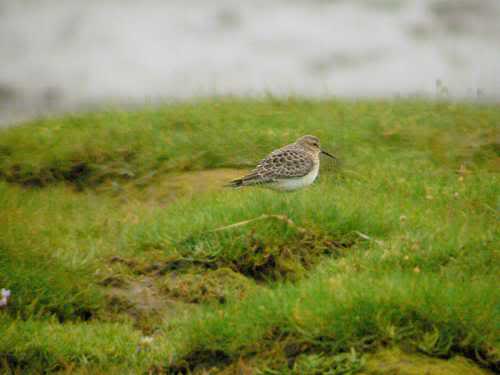
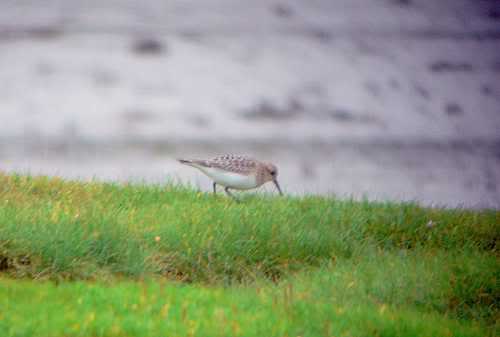
Links:
Oiseaux net
Hockey, P.A.R. 1998. Africa’s waders: a guide to their identification. Part 1. Africa - Birds & Birding 3(1):53-61.


Links:
Oiseaux net
Hockey, P.A.R. 1998. Africa’s waders: a guide to their identification. Part 1. Africa - Birds & Birding 3(1):53-61.
Dewi
What is the good of having a nice house without a decent planet to put it on? (H D Thoreau)
What is the good of having a nice house without a decent planet to put it on? (H D Thoreau)


